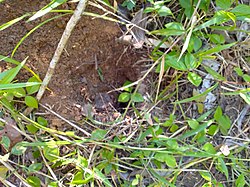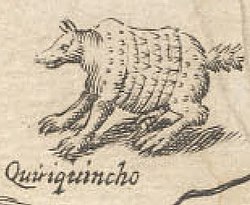Dasypodidae
The dasipods (Osman), commonly known as armadillos, are a family of placental mammals of the order Cingulata. They are characterized by having a dorsal carapace made up of juxtaposed plates, generally arranged in transverse rows, with a fairly long tail and short limbs. They live in America.
Common names
The members of the Dasypodidae family receive various names, the most common being armadillo; they are also called (sometimes depending on the species) quirquincho (from Quechua kirkinchu) in Argentina, Bolivia, Chile, Colombia and Peru; cuzuco in Costa Rica, El Salvador, Honduras and Nicaragua; mulita in Argentina, Paraguay and Uruguay; tatú (tatú, tatú cart) in Argentina, Bolivia, Brazil, Paraguay and Uruguay; hairy in Argentina, Chile, Colombia and Uruguay; piche in Argentina, Brazil, Chile, Colombia and Paraguay; cachicamo in Colombia and Venezuela; gurre in Tolima, Caldas and Antioquia, Colombia; jerre-jerre on the Caribbean coast of Colombia; jueche in southeastern Mexico; toche in the state of Veracruz, Mexico); and carachupa in Peru.
Features
Armadillos are easy-to-recognize mammals, distinguished by their armor consisting of bony plates covered by horny shields that serve as protection, and that in some genera allow the animal to roll up into a ball. Externally they look a bit similar to pangolins, mammals from Africa and Asia covered with huge scales or plates, and which have similar habits. This is the reason why they were classified in the same order in the past, but it is now clear that they are not related, with armadillos belonging to the order (or superorder) Xenarthra and pangolins to the order Pholidota.
Armadillos have diverged very little from the mammalian ancestral plan and are a very old group, already differentiated in the Paleocene.
The teeth of the armadillo are simple and uniform cylindrical structures, without enamel and with open roots and continuous growth; their number is very high, up to 25 in each jaw.
The most widespread species is the nine-banded armadillo (Dasypus novemcinctus), the only one that reaches the United States from the south. This species and the species Cabassous centralis are the only ones that have a distribution range that extends outside of South America, where all the species of the family inhabit and, according to the known fossil record, are the origin site.
Biology and ecology
Armadillos are nocturnal and burrowing creatures. They are insectivorous and omnivorous necrophagous typical of tropical Central America and South America.
Human relations between armadillos
Its shell is used to make charangos, which have great commercial value.
In Tabasco, Mexico this animal is known as "jueche" and it used to be used for human consumption until it was declared endangered.
In Central America, the armadillo is known as cusuco. Despite the fact that in El Salvador it is associated with leprosy (since the skin on its belly seems to contain it) it is consumed by some of its inhabitants, especially in the city of San Alejo, Department of San Miguel. The cusuco is also consumed at least in Honduras and Nicaragua.
In Colombia, it is taken out of its burrows using a homemade torch to shoot smoke that is usually placed over the hole to later add a sack of fique (a sack in which coffee is normally transported) and capture it. In addition to this, although its consumption has decreased in recent years, it is still consumed in the same way as it is done in other countries such as Central and South America.
In Colombia and Ecuador it is consumed by the Awá nation.
The meat is used for human consumption and given its flavor it is known as the “seven meats”, since it is similar to chicken, rabbit, and pork. The peasants usually bone the animal and prepare the meat inside the shell to eat it roasted, fried and stewed. After frying the shell, it is chewed in a similar way to pork rinds or skin.
The shell and tail are used for traditional medicinal practices. These are left to roast and are ground until they become a powder, which is boiled in water to be drunk by "first-time" women (first pregnancy), and cure the discomfort that this causes. According to many peasants, asthma is cured by drinking the blood of a freshly slaughtered armadillo, to hide the bad taste it is washed down with a sip of brandy.
The armadillo can carry certain microorganisms that cause diseases in humans such as Mycobacterium leprae, the bacterium that causes leprosy. Likewise, it is considered a reservoir of flagellated protozoa of the species Trypanosoma cruzi, which causes a very serious illness called Chagas disease in humans, especially children. Given the aforementioned sanitary importance, in Venezuela legislation has been in force since 1982 to prohibit the hunting of this species, in addition to the Priodontes giganteus or maximus, which is the giant armadillo and the Dasypus sabanicola or sabanero cachicamo, the most common in Venezuela.
It is known that in Europe, the US, Mexico and Venezuela, studies are being carried out based on the armadillo in order to find medicines to treat, in addition to these diseases, others such as leishmaniasis and yellow fever.
There is a city that owes its name to this animal, Ayutuxtepeque, which means "hill of armadillos or cusucos".
Taxonomy
Dasipodids include three subfamilies, with nine extant genera and numerous extinct genera. it ranked with modern armadillos as the sister taxon of a clade consisting of the subfamilies Chlamyphorinae and Tolypeutinae. For this reason glyptodontids and all modern armadillos were reclassified in the family Chlamyphoridae, except for members of the genus Dasypus which continue as part of the Dasypodidae.
Subfamily Dasypodinae
- Astegotherium†
- Dasypodon†
- Parastegosimposonia†
- Propraopus†
- Prostegotherium†
- Pseudostegotherium†
- Riostegotherium†
- Stegosimponia†
- Stegotherium†
- Dasypus
- Dasypus novemcinctus
- Dasypus septemcinctus
- Dasypus hybridus
- Dasypus sabanicola
- Dasypus yepesi
- Dasypus kappleri
- Dasypus pilosus
Contenido relacionado
Bovidae
Choeropsis liberiensis
Bubalus arnee
Puma concolor
Thomas Bewick


